What does a farmer look like? Turbaned, dhoti-clad, muddy-legged, and sweaty-browed? Driving a tractor or, an old-fashioned stereotype, ploughing a field with a pair of bullocks? A smiling face on a bag of organic grain or, another stereotype, a cheery figure, a sheaf of grain on one shoulder and a sickle in his hand?
The Indian farmer, in a country that has long been agriculture-dependent, is the stuff of folklore, the hero of popular culture. The face of the countryside. And, occasionally, a face that arrives in the city and makes its presence felt.
Also Read | Punjab farmers’ year-long border protest gains new momentum
In September 2020, the Union government promulgated three contentious laws aimed at reforming the agricultural sector. The laws implied major changes in the cultivation and trade of crops. For one, they aimed to facilitate the trading of agricultural produce outside of the age-old mandis (wholesale markets) which the farmers were used to. Second, they promoted the idea of contract farming, which meant that private corporations could control the cultivation of crops. Third, they proposed to cancel out the government’s monopoly on the stockpiling of essential commodities for emergencies by allowing private entities to hoard as well. In effect, the three laws allowed private players to have a free run of the agricultural sector.
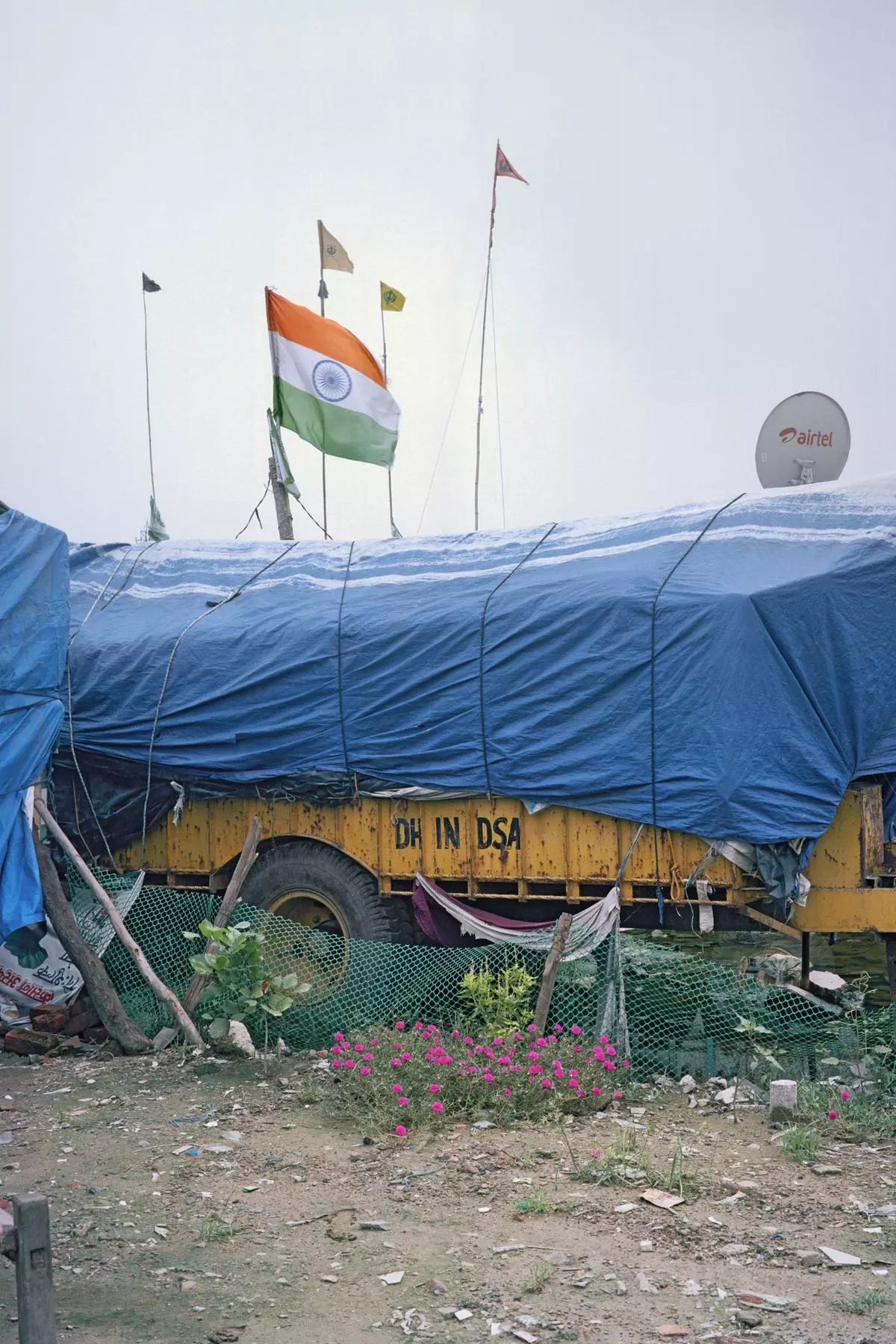
Untitled (43). From Gauri Gill’s series “The Village on the Highway” (2021).
| Photo Credit:
Gauri Gill
Within days of the laws being announced, a rash of protests broke out, especially in the farmlands of Punjab and Haryana. Soon after, farmers’ unions across Punjab, Haryana, and Uttar Pradesh came together to form the Samyukta Kisan Morcha (SKM) to helm the protests in a peaceful, non-violent manner. The SKM began a Jail Bharo Andolan, called for a general strike, and finally raised a cry that echoed Subhas Chandra Bose’s revolutionary “Dilli Chalo”.
In late November, hundreds of farmers from across Punjab, Haryana, and the neighbouring States converged on Delhi, demanding the repeal of the three laws. The farmers were faced with tear gas and water cannons and a government determined to maintain its stance.
Landmark protest
The farmers’ protest of 2020-21 was to become a landmark event in modern Indian history. Over the year that followed the arrival of the farmers at Delhi’s borders and until the farm laws were finally repealed, the protest burgeoned. It spread far beyond the farming community, joining hands with other movements. It gathered ramifications well beyond the act of opposing unfair farm laws.
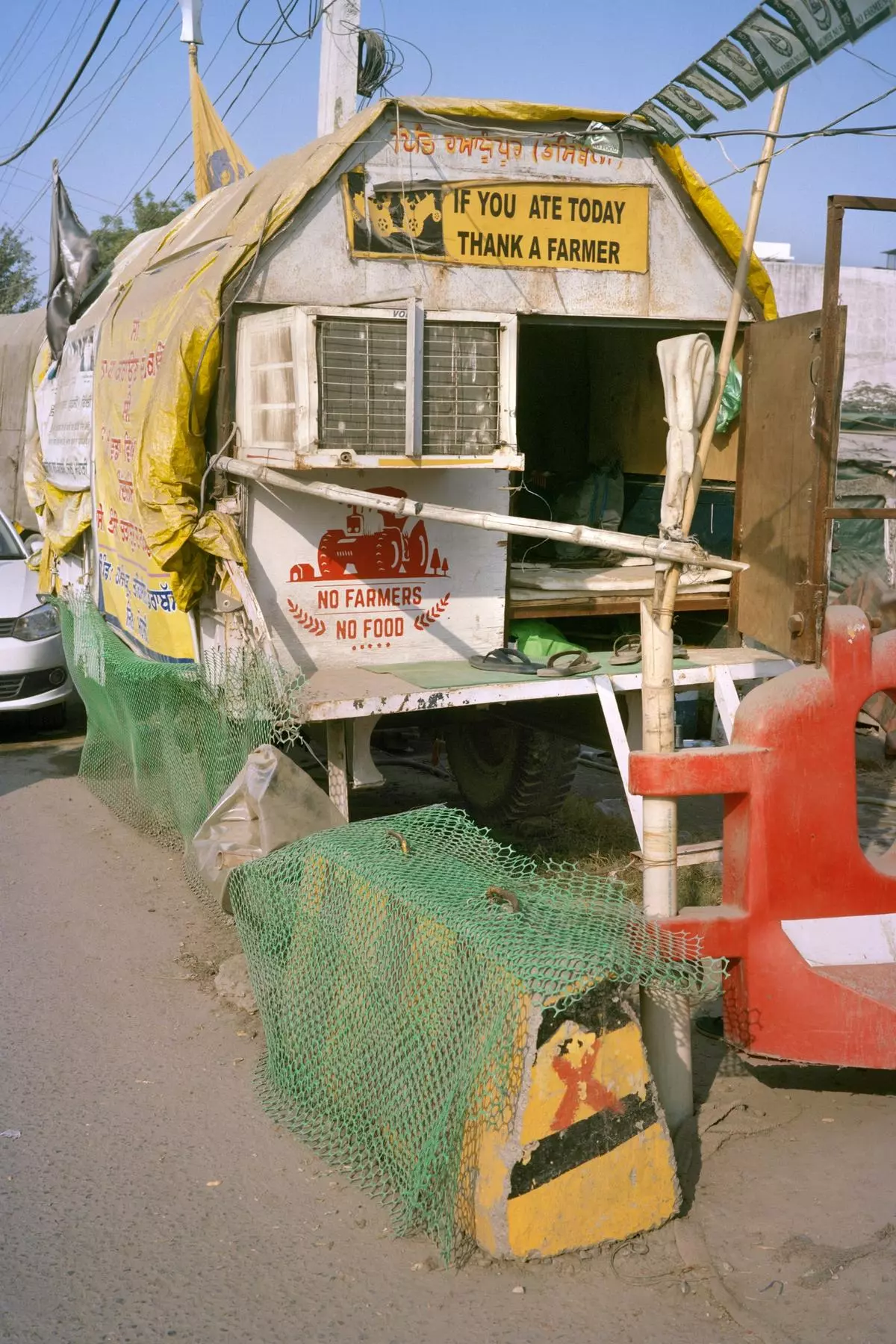
Untitled (35). From Gauri Gill’s series “The Village on the Highway” (2021).
| Photo Credit:
Gauri Gill
Little wonder, then, that for 12 months—November 2020 to November 2021—the legions of farmers who settled down, trucks and tractors and all, on Delhi’s borders became the focus of national news. There were reports, editorials, and interviews. There were photographs, showcasing both (or one of the) sides of the issue, bringing to the public glimpses of the farmers as they waged a seemingly impossible battle against the state.
Amongst the many photographers who recorded the protest was the Delhi-based Gauri Gill, whose exhibition “The Village on the Highway” is now on display at Delhi’s Vadehra Art Gallery (February 4–March 4). Consisting of about 90 photographs, the exhibition is a visual documentation of an oft-ignored aspect of protests: the quotidian life of the protesters, underlining their humanness. Not their act of protest, not their anger or their arguments, but the way they settled in and made for themselves a home far away from home. Over a period of some 11 months, from January to December 2021, Gill photographed this settlement, the “village” that had mushroomed on the highway leading to the national capital.
A home on the highway
At first, the settlement in Gill’s photographs looks uncannily like the many jhuggi-jhopdi (slum) clusters that dot Delhi. Blue, green, and yellow tarpaulins stretch from pole to pole, forming ceilings, walls, tents. Bamboo fences demarcate spaces; ropes become clotheslines and hangers. An Airtel dish antenna stands tall, tied with rope to a bamboo pole; beyond, on a neglected green signboard is an ironic message, many of its letters long vanished: Dilli mein aapka haardik swaagat hai (Delhi welcomes you).
“Gill’s focus expands beyond the faces of the farmers. The only faces to be seen in these photos are of Bhagat Singh, Che Guevara, Babasaheb Ambedkar, and Baba Banda Singh Bahadur.”
A closer look reveals interesting details. Not all of these structures are tethered to the ground: they are not huts. These are trucks and tractor trolleys turned into dwelling places. Not just impersonal shelters, but homes. Spaces that have been repurposed to serve as bedrooms and kitchens, storerooms and living rooms, often with a remarkable level of ingenuity.
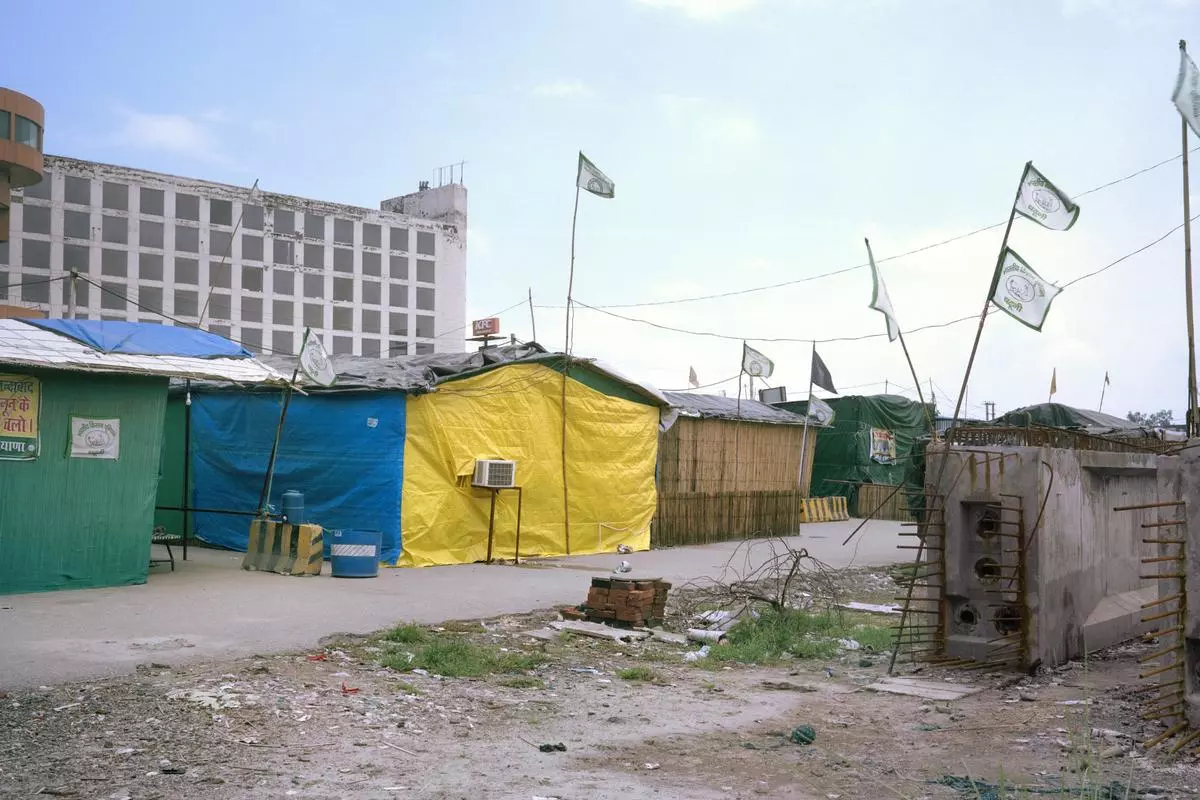
Untitled (68). From Gauri Gill’s series “The Village on the Highway” (2021).
| Photo Credit:
Gauri Gill
For instance, in one photograph (prominent because of the English-language signs: “If You Ate Today Thank a Farmer” and “No Farmers No Food”), a vehicle—you can see the wheels underneath—has been outfitted with a wooden door and a water cooler. An attempt has even been made to ensure some privacy: the space has been enclosed using bamboo poles and the yellow-and-black concrete barriers ubiquitous on Delhi’s roads.
Semblance of normalcy
Water coolers, rugs, plastic furniture—especially stools, so portable, so stackable, so multipurpose—are visible in several photographs. There are curtains here, a mirror hanging there, complete with a comb tucked beside it. Brightly patterned rugs line earthen floors. Interestingly, slippers and shoes lie on those rugs. This may be a makeshift home, but for the time it is home, cleanliness must be maintained: footwear must not be brought in.
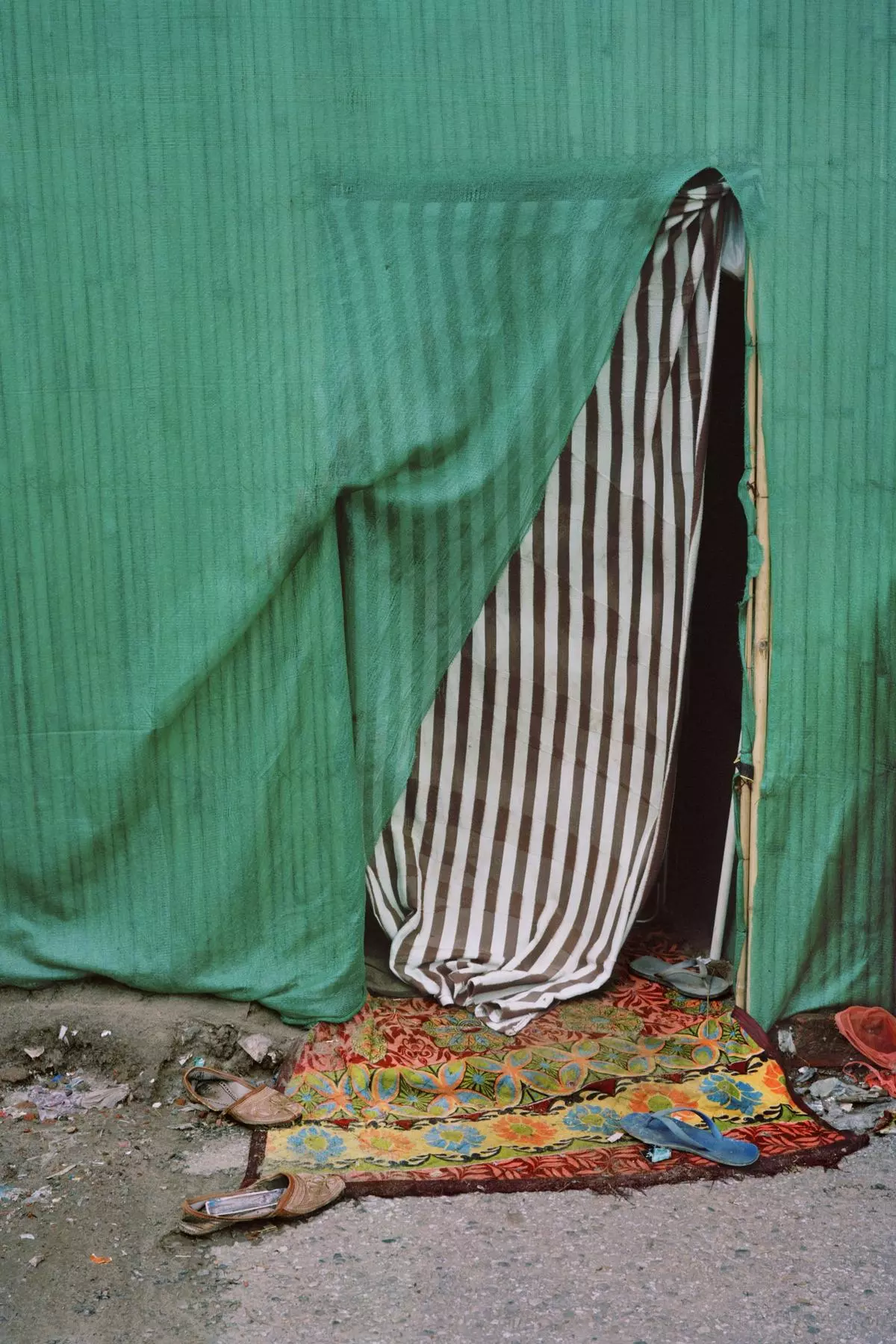
Untitled (46). From Gauri Gill’s series “The Village on the Highway” (2021).
| Photo Credit:
Gauri Gill
This attempt at maintaining a semblance of normalcy is echoed in other photographs, other scenes. In one photograph, a small twig broom lies in the middle of a narrow lane. Off to one side is a small heap of mineral water bottles. Someone has been cleaning up, emphasising the fact that this is not a temporary site of protest but has become home. In another photo, on the edge of a “boundary wall” made up of sturdy green mesh leaning against a concrete block, there are flowers in bloom: an obvious attempt at a small garden, something to brighten up the “domestic” space.
Coming together
Equally emphatic is a sense of community, of families united for a common cause. The back of a large truck has been converted into what seems like a common laundry. Large plastic water tanks sit on the floor around it, along with a huge, soot-stained patila (large pot) that is probably being used as a washtub. The sides of the truck are draped with newly washed blankets while clean garments hang on a clothesline.
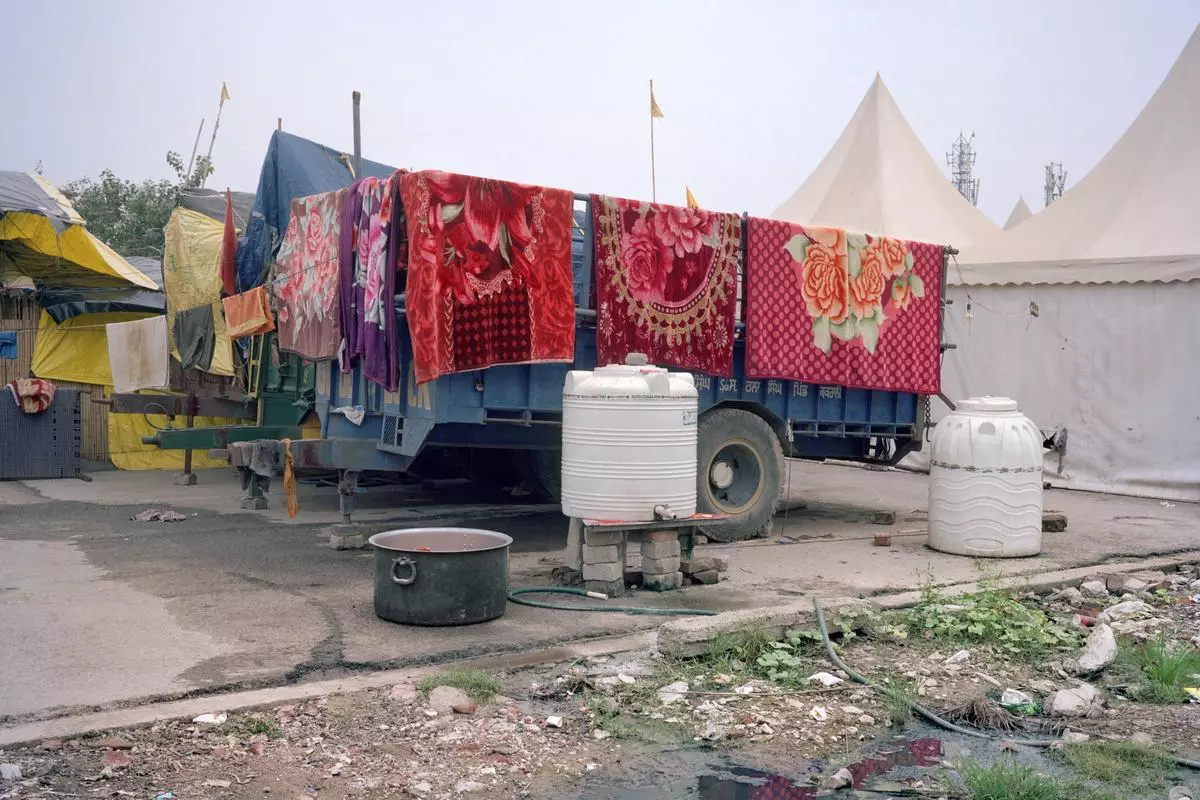
Untitled (4). From Gauri Gill’s series “The Village on the Highway” (2021).
| Photo Credit:
Gauri Gill
Another photograph gives a glimpse of a communal kitchen, with gas cylinder, assorted large kadhais (woks), patilas, paraats (platters), and shallow baskets. The community kitchen carries meaning that goes beyond what is visible in Gill’s photograph: during the year-long protest, food cooked in these kitchens, in the form of langar, was distributed not just among the farmers and their families but also among outsiders, including the police personnel who were on duty to keep the protesters out of Delhi.
Sleeping bodies
One of the most striking aspects of Gill’s photographs is the lack of faces. This contrasts with usually seen photographs of the event that highlight the people, their faces, expressions, gestures. Whether Shome Basu or Vikas Bajpai, Prakash Singh or Danish Siddiqui—almost all the photographers and photojournalists who covered the farmers’ protest highlighted the people who participated in it. Indeed, this is a common theme in photojournalism: google “protest photos”, and you will get an overwhelming number of images featuring people with angry eyes, open mouths, defiant expressions. Faces that dare to speak up.
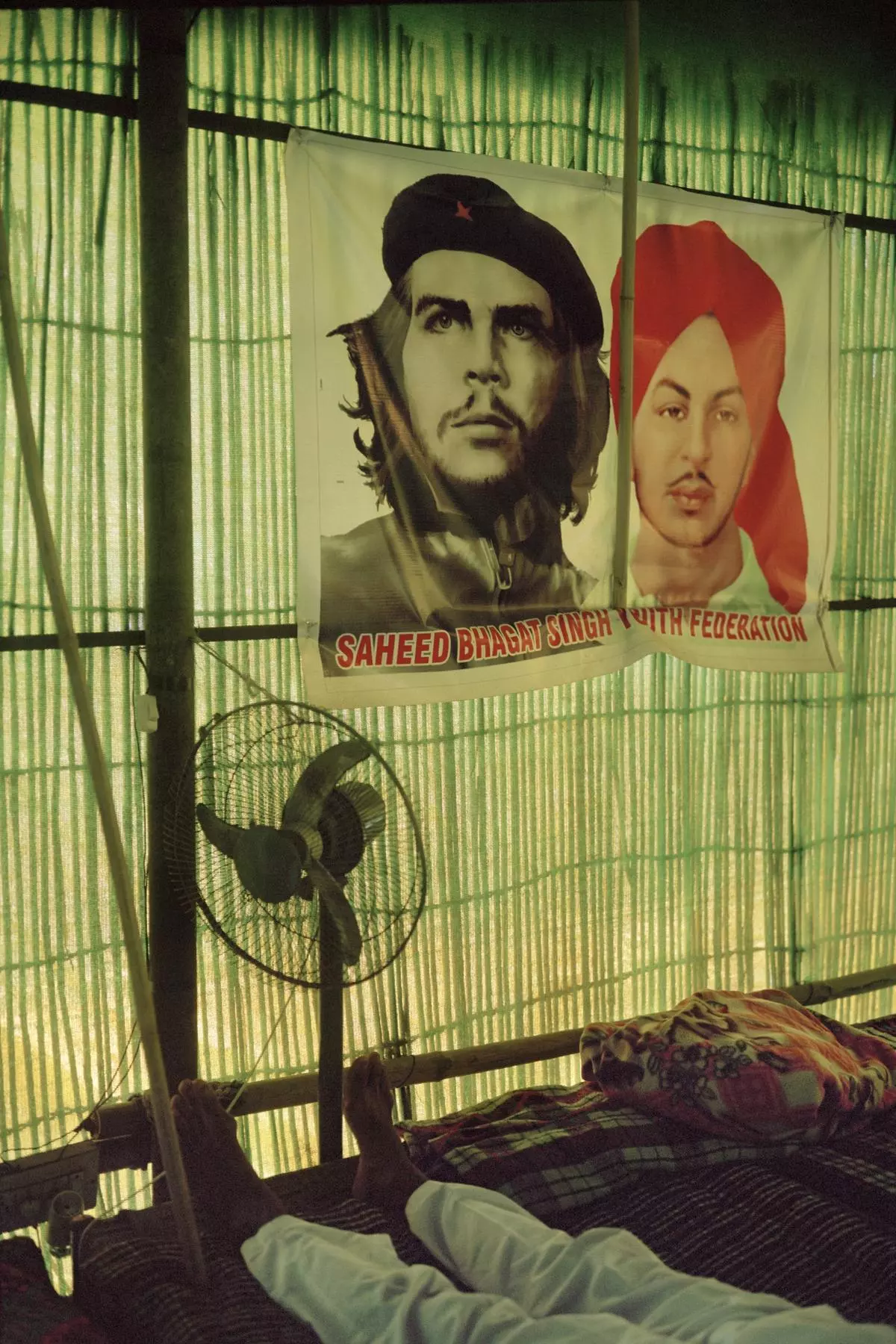
Untitled (44). From Gauri Gill’s series “The Village on the Highway” (2021).
| Photo Credit:
Gauri Gill
Gill’s focus expands beyond the faces of the farmers. The only faces to be seen in these photographs are of Bhagat Singh, Che Guevara, Babasaheb Ambedkar, and Baba Banda Singh Bahadur—the quintessential faces of dissent, the icons who stood up for their ideals. The featured farmers are not faces but sleeping bodies: a man in a truck, his face turned away from the camera; a pair of pyjama-clad legs stretched out on bedding.
And yet Gill makes the objects she chooses to photograph—from the trucks and makeshift homes to the tarps, the blankets, the kadhais, and stoves—speak resoundingly of the everydayness of the farmers, who yet became something extraordinary by making their protest felt. They speak of the farmers’ ingenuity, that oft-admired Indian penchant for jugaad. Of their resilience, the way they made a home for themselves many miles from home using the most rudimentary of materials.
Also Read | Is the National Policy Framework on Agricultural Marketing a backdoor for withdrawn farm laws?
This peek behind the placards humanises the protesters, making them one of us—which adds to the realisation that the farmers’ protest was also our protest, that the farmers fought not just for themselves but for all Indians. At the same time, the living spaces touchingly cobbled together from this and that point to the farmers’ resilience, to human resilience. It is noteworthy here that the Union government repealed the farm laws in November 2021, after almost a year of relentless protest.
Gill has explained that her practice is to focus on “how people in precarity find ways to float rather than drown”. “The Village on the Highway” is a tribute to human tenacity, a memorable behind-the-scenes look at what has been described as the largest and longest peasants’ struggle in the history of modern India.
Madhulika Liddle is a novelist and short story writer.




